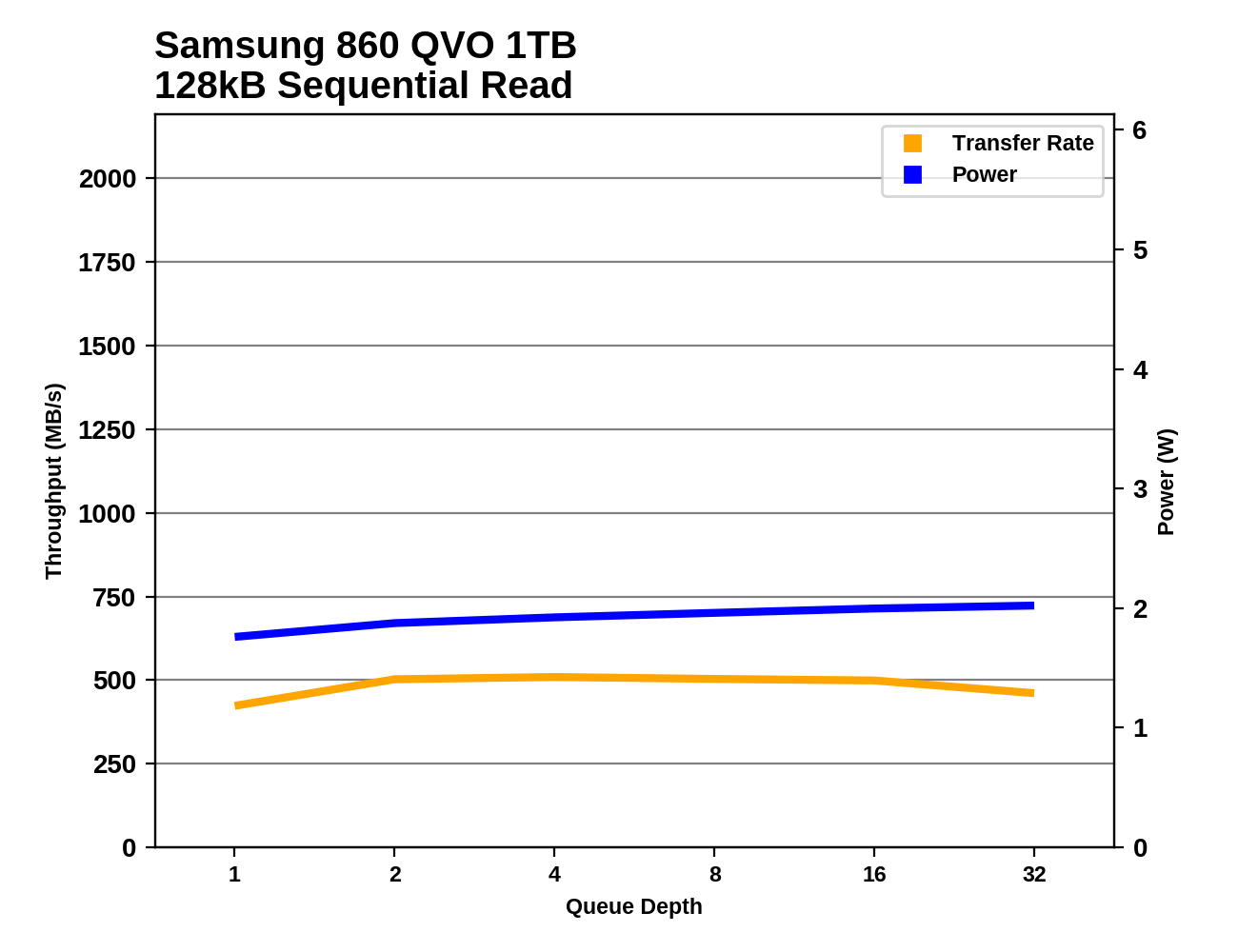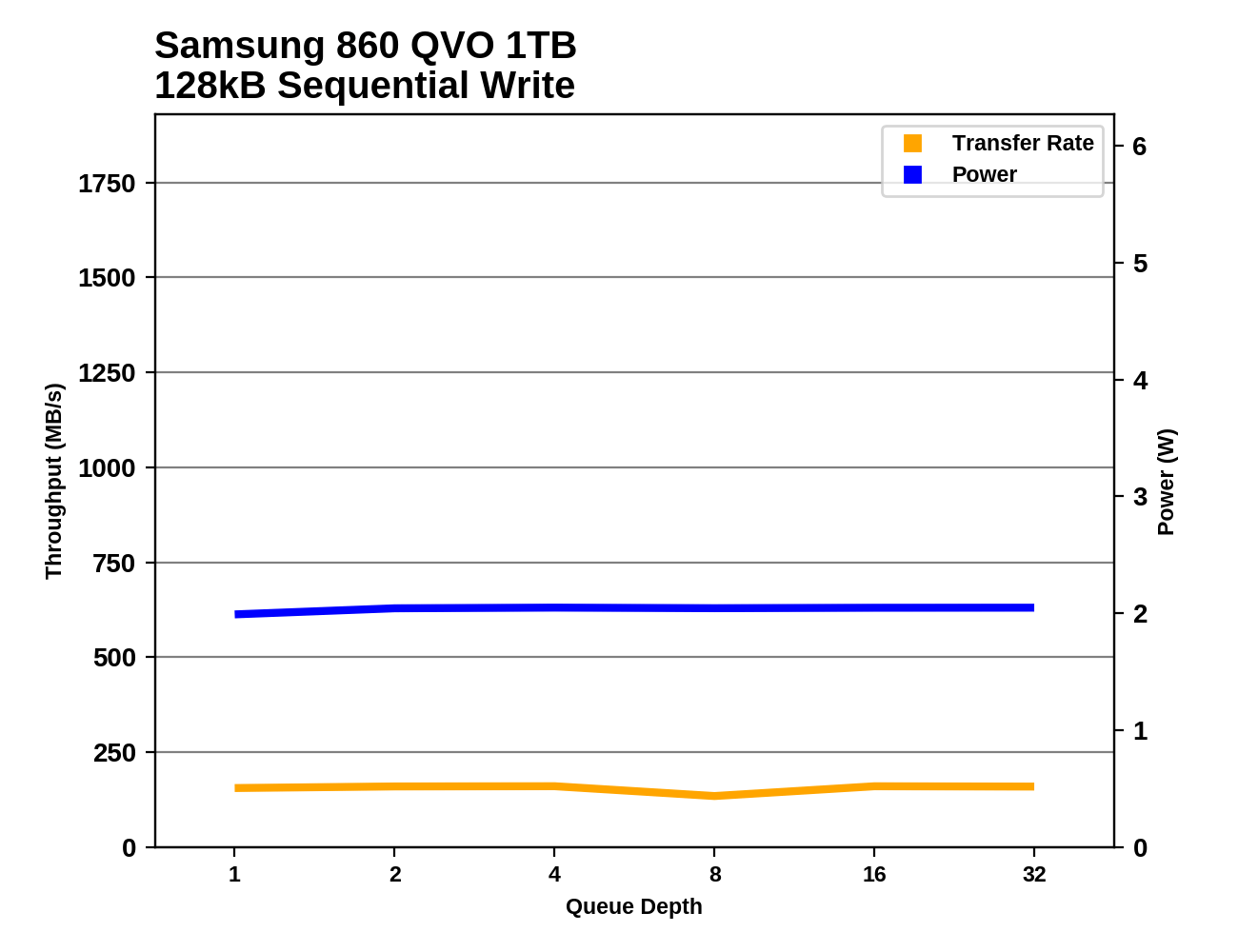The Samsung 860 QVO (1TB, 4TB) SSD Review: First Consumer SATA QLC
by Billy Tallis on November 27, 2018 11:20 AM ESTSequential Read Performance
Our first test of sequential read performance uses short bursts of 128MB, issued as 128kB operations with no queuing. The test averages performance across eight bursts for a total of 1GB of data transferred from a drive containing 16GB of data. Between each burst the drive is given enough idle time to keep the overall duty cycle at 20%.

The burst sequential read performance of the Samsung 860 QVO is generally competitive with mainstream TLC SATA SSDs and is well ahead of the DRAMless Toshiba TR200. The 1TB 860 QVO's score is a bit lower when the drive isn't full because of the timing of the tests: the drive was still flushing the SLC cache in the background when the read test started.
Our test of sustained sequential reads uses queue depths from 1 to 32, with the performance and power scores computed as the average of QD1, QD2 and QD4. Each queue depth is tested for up to one minute or 32GB transferred, from a drive containing 64GB of data. This test is run twice: once with the drive prepared by sequentially writing the test data, and again after the random write test has mixed things up, causing fragmentation inside the SSD that isn't visible to the OS. These two scores represent the two extremes of how the drive would perform under real-world usage, where wear leveling and modifications to some existing data will create some internal fragmentation that degrades performance, but usually not to the extent shown here.

On the longer sequential read test, the 860 QVO continues to get reasonably close to the SATA speed limit when reading data that is contiguous on the flash itself. Where internal fragmentation is caused by writing to the drive randomly, the QVO's read speed suffers much more than for the TLC drives, and the 1TB 860 QVO ends up slightly slower than a mechanical hard drive.
 |
|||||||||
| Power Efficiency in MB/s/W | Average Power in W | ||||||||
The power efficiency of the 860 QVO is only a little bit lower than the TLC drives for the contiguous data case. When dealing with fragmented data, the QVO is slightly more efficient than the Intel/Micron NVMe QLC drives despite being a bit slower.
 |
|||||||||
The queue depth scaling behavior for the 860 QVO is very typical, with QD1 not quite saturating the SATA link but all higher queue depths hitting close to full speed. The one exception is a slight decrease from the 1TB drive during the final QD32 phase.
Aside from the mild QD32 drop in performance, the sequential read behavior of the 860 QVO doesn't fall outside the normal ranges we've come to expect from TLC drives.
Sequential Write Performance
Our test of sequential write burst performance is structured identically to the sequential read burst performance test save for the direction of the data transfer. Each burst writes 128MB as 128kB operations issued at QD1, for a total of 1GB of data written to a drive containing 16GB of data.

The Samsung 860 QVO handles the burst sequential write test fine when the drive is mostly empty and there's plenty of room in the SLC cache. When the drive is full, the 1TB model's speed suffers somewhat, but is still much faster than the mechanical hard drive or the DRAMless TLC drive.
Our test of sustained sequential writes is structured identically to our sustained sequential read test, save for the direction of the data transfers. Queue depths range from 1 to 32 and each queue depth is tested for up to one minute or 32GB, followed by up to one minute of idle time for the drive to cool off and perform garbage collection. The test is confined to a 64GB span of the drive.

On the longer sequential write test, the SLC cache of the 1TB 860 QVO is not quite enough even when the drive is mostly empty, so it ends up in last place. The 4TB model's SLC cache keeps up with this test and it is as fast as any SATA drive.
 |
|||||||||
| Power Efficiency in MB/s/W | Average Power in W | ||||||||
The 860 QVO is a bit more power-hungry than the 860 EVO, so the 4TB QVO only takes third place for efficiency among the SATA drives in this bunch. The 1TB QVO has similar efficiency to the faster but more power-hungry 1TB QLC NVMe drives from Intel and Micron.
 |
|||||||||
The 1TB 860 QVO is mostly slow and steady during the sequential write test, while the 4TB model's performance is as good as any other SATA drive.
The 1TB 860 QVO's sequential write behavior sticks out clearly as far slower than typical, but it's not unprecedented: there have been TLC drives this slow, but most of them were much smaller than 1TB. The 4TB model blends in with the crowd much better.












109 Comments
View All Comments
Impulses - Thursday, November 29, 2018 - link
Bleh, googling revealed that WAS on Amazon... It never triggered my price alerts, hrm, even tho it's definitely showing on Camelcamel's price history now, weird. Maybe I glossed over it entirely, oh well.The_Assimilator - Thursday, November 29, 2018 - link
https://www.pcgamer.com/crucials-2tb-mx500-ssd-is-...hojnikb - Tuesday, November 27, 2018 - link
@BillyCan you do a data retention test ? Like writing the drive with data (H2testw seems to be the pick of the bunch) and disconnecting it. I'm interested how data retention holds up over time.
JoeyJoJo123 - Tuesday, November 27, 2018 - link
Don't use SSDs for cold storage. Testing this is absurdly stupid and a waste of a reviewers time.Disconnect drive for 10 days: Replug it in and verify data's still all there. Yep.
Disconnect drive for 15 days: Replug it in and verify data's still all there. Yep.
Disconnect drive for 20 days: Replug it in and verify data's still all there. Yep.
(We're already at 45 days, or 1.5 months, and chances are the data's still all there, are you getting how and why this kind of testing is stupid?)
By the time you get to sufficiently long enough time periods to see some change in data you'd have wasted over a year trying to find a time period (within 5 days) where you know the drive will start losing data. This is just as absurd as asking reviewers to test NAND flash endurance by hammering the drive 24/7 for years until it dies. By the time it DOES die something better will have already arrived on the market. And disregarding all that, testing with a sample size of ONE is not indicative of any relevant performance characteristics for your ONE drive.
If you want to use cold storage backups, either use a mechanical hard drive, a tape drive, or invest in cloud storage and encrypt your data before uploading it.
Testing the cold storage capabilities of a sample size of ONE QLC SSD does nothing but prove that it's a less satisfactory use case for the technology than using a mechanical hard drive.
HollyDOL - Tuesday, November 27, 2018 - link
I _think_ you can find Google or Facebook statistics on their SSDs, error rate etc. in representative volumes. But ofc it is enterprise grade hardware.hojnikb - Wednesday, November 28, 2018 - link
Not for QLC.hojnikb - Wednesday, November 28, 2018 - link
You're not thinking very far. As QLC is very cheap, it will be used in likes of flash drives, SD cards and portable SSDs. With these, it's not expected for them to be powerred at all time and in the case of sd cards and flash drives, it's not likely controller would do any kind of data rewritting.So this is very much a relavant test, that might give us ideas on how it performs. And no, you don't have to wait a year to see something; data curruption can be presented a lot sooner if from of read error and slower read speed in general. A more extreme approach is to heat the drive, which accelarates the process.
eddieobscurant - Tuesday, November 27, 2018 - link
Horrible performance by samsung 64 layer qlc nand. Way slower than intel's/micron's . Especially the 4k random reads are slower than my first ssd 10 years ago, the intel x-25m.In order for samsung 860 qvo to make sense, it should be priced below 0.10$/gb
stargazera5 - Tuesday, November 27, 2018 - link
Great, now that we have QLC down, we can move on to PLC (5 bits per cell) and 1 drive write per week.CheapSushi - Wednesday, November 28, 2018 - link
And from the current trend, it still won't be much cheaper. =P